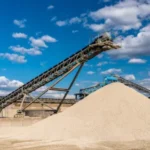What Is Frac Sand and How Is It Used in Hydraulic Fracturing?

Of all the components in the hydraulic fracturing process, a high-purity quartz sand known as frac sand is one of the most essential. While often overlooked, this specialized sand is critical to the success of extracting oil and natural gas from unconventional reservoirs. Its unique properties and function as a proppant make it a cornerstone of modern drilling operations.
This article explores the role of frac sand in hydraulic fracturing, including its definition, use, different types, and the terminology surrounding it. It also examines the chemical technologies that work in tandem with frac sand to optimize well productivity. This information is valuable for oilfield engineers, procurement teams, chemical specialists, and other energy industry stakeholders.
Defining Frac Sand
Frac sand is a type of sand with uniform, small particles that is used to prop open the fractures created during hydraulic fracturing. It is a naturally occurring crystalline silica (quartz) sand that is processed from high-purity sandstone. Unlike common sand, which is a mix of various minerals and rock types, frac sand is composed of at least 99% quartz, making it exceptionally durable.
Key characteristics that distinguish high-quality frac sand from regular sand include :
- High Purity: Composed almost entirely of silica quartz, giving it the required strength.
- Crush Resistance: It can withstand the immense pressure deep within a well without breaking down.
- High Sphericity and Roundness: The round, uniform grain shape creates more effective pathways for oil and gas to flow.
- Consistent Grain Size: Frac sand is sorted into specific mesh sizes to suit different geological formations.
Because of these properties, frac sand is the most widely used proppant—a solid material designed to “prop” open the fractures created during the fracking process, ensuring that oil and gas can flow freely to the wellbore.
What Is Frac Sand Used For In Hydraulic Fracturing
Hydraulic fracturing, or fracking, is a well stimulation technique used to extract hydrocarbons from low-permeability rock formations like shale. The process involves pumping a mixture of water, chemical additives, and a proppant (frac sand) into a well at extremely high pressure.
The process involves several key steps:
- High-Pressure Injection: A specialized fluid, primarily composed of water and chemical additives, is pumped into a well at extremely high pressure. Sunita Hydrocolloids Inc. (SHI) is a leader in developing these critical chemical additives, such as guar gum-based gelling agents.
- Fracture Creation: The pressure exerted by the fluid exceeds the rock’s breaking point, creating a network of fractures that extend deep into the formation.
- Proppant Transport: Frac sand, suspended within the viscous fracturing fluid, is carried deep into these newly created fractures. The gelling agents, like SHI’s SUNCOL products, are essential for thickening the fluid, enabling it to effectively transport the proppant without it settling prematurely.
- Maintaining Permeability: Once the pumping pressure is released, the fractures naturally start to close. The frac sand, however, remains in place, propping the fissures open. This creates a lasting, permeable channel through which oil and gas can flow into the well.
Types of Frac Sand and Proppants
Proppants are selected based on the specific pressures and conditions of a geological formation. While several materials can be used, different types of frac sand are the most common.
Northern White Sand
Sourced primarily from Wisconsin and Minnesota, this is considered the highest quality frac sand due to its exceptional purity, strength, and roundness. Its durability makes it suitable for a wide range of hydraulic fracturing operations, including in high-pressure wells.
Brown Sand
Also known as Hickory or Brady sand, this type comes from Texas and has a lower quartz content than Northern White sand. It is generally used in shallower wells with lower pressure conditions.
Resin-Coated Sand
This is frac sand coated with a layer of resin, which strengthens the proppant and helps prevent it from flowing back out of the fracture with the oil and gas. The resin coating bonds the sand grains together within the fracture, improving long-term well productivity.
Ceramic Proppants
As an alternative to sand, ceramic proppants are manufactured from sintered bauxite or alumina. Though more expensive, they offer superior strength and are used in very deep, high-pressure formations where frac sand might be crushed.
Proppants are also categorized by mesh size, which indicates the grain diameter. Common sizes include 20/40, 30/50, and 100 mesh. The choice depends on the required fracture width and reservoir characteristics; finer grains offer more surface area, while larger grains provide greater structural support.
Understanding Frac Flowback
After the hydraulic fracturing process is complete, a portion of the injected fluid returns to the surface. This returning fluid is known as “flowback” and contains water, chemical additives, and some of the proppant that did not remain lodged in the fractures.
Managing flowback is a critical operational and environmental challenge. If too much proppant flows back, it can indicate that fractures are not being propped open effectively.
This “sand production” can also cause significant damage to production equipment like electric submersible pumps (ESPs). Additives such as breakers are used to reduce the fluid’s viscosity and improve flowback efficiency, while technologies like resin-coated sands help minimize proppant flowback itself.
What Is Fracking Sand?
“Frac sand” and “fracking sand” refer to the same material: a high-purity, crush-resistant silica sand used in hydraulic fracturing. This specialized sand acts as a proppant, a solid material designed to keep induced fractures open to allow oil and gas to flow.
The primary difference between the terms lies in their common usage. “Frac sand” is the more precise, technical term favored within the oil and gas industry. In contrast, “fracking sand” is a term more frequently used in media reports and public discussions, as it directly connects the material to the process of “fracking”. While the terminology may vary by audience, both names describe the durable quartz sand essential for this extraction method.
The Role of Chemical Additives
While frac sand provides the necessary mechanical support, a variety of chemical additives are essential for optimizing the hydraulic fracturing fluid’s performance. These additives typically make up less than 1% of the total fluid mixture but play crucial roles.
Common additives and their functions include :
- Gelling Agents and Crosslinkers: Natural guar, cellulose, and other polymers increase the fluid’s viscosity, allowing it to carry more frac sand deeper into fractures.
- Friction Reducers: These chemicals, also known as slickwater additives, reduce pumping pressure, making the injection process more efficient.
- Breakers: Added to break down the gelling agents once the proppant is in place, which reduces the fluid’s viscosity and allows oil and gas to flow more easily.
- Biocides: Control the growth of bacteria that can cause corrosion or clog fractures.
- Clay Stabilizers: Prevent clay minerals within the rock formation from swelling when they come into contact with water, which could block hydrocarbon flow.
- Surfactants: Reduce the surface tension between the fluid, rock, and hydrocarbons to improve fluid recovery and flow rates.
The synergy between high-quality frac sand and these specialized chemicals is critical. Chemical technologies ensure that the proppant is placed effectively, fractures remain open and clean, and the overall fracturing process delivers maximum productivity and operational reliability.
The Role of Sunita Hydrocolloids in Oilfield Operations
While frac sand provides the structural support for fractures, its effective placement depends on the advanced chemical composition of the fracturing fluid. Sunita Hydrocolloids Inc. (SHI), a subsidiary of a 40-year industry leader, specializes in innovative oilfield chemical technologies that optimize this process.
SHI offers an extensive range of fast hydrating Guar gum powder under the brand name SUNTECH-FH. These products are compatible with other additives commonly used in formulation of drilling fluids and can function as viscosifier, suspension and gelling agent.
This enhanced viscosity is crucial for suspending and transporting frac sand deep into the fracture network, ensuring optimal proppant placement and maximizing well productivity.
With state-of-the-art R&D and a robust supply chain headquartered in Houston, Texas, SHI provides essential chemical solutions that enable the successful application of proppants in modern oil and gas operations.
You can request detailed data sheets for all SUNTECH-FH products through our 24/7 active support center at +1 832 324 2345. We can customize our products to meet your specific requirements.





